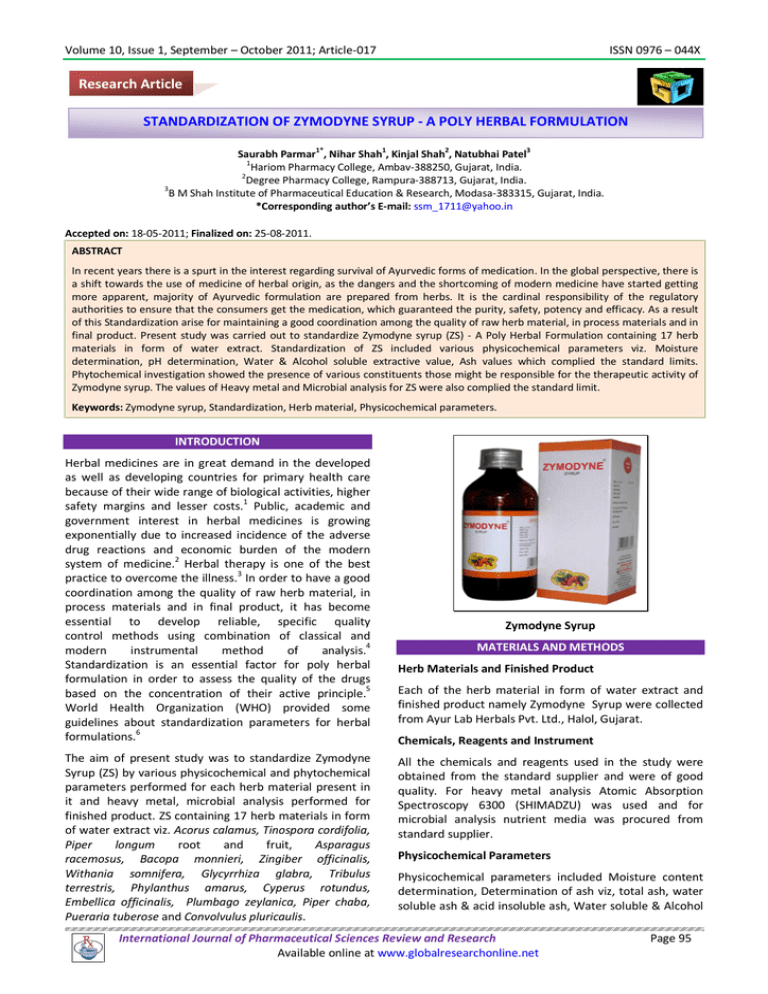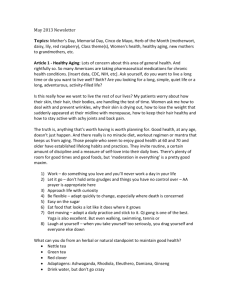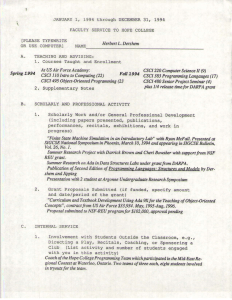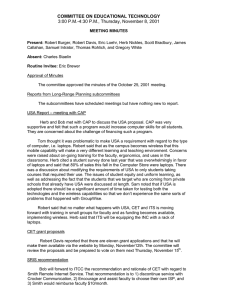Document 13308115
advertisement

Volume 10, Issue 1, September – October 2011; Article-017 ISSN 0976 – 044X Research Article STANDARDIZATION OF ZYMODYNE SYRUP - A POLY HERBAL FORMULATION 1* 1 2 3 Saurabh Parmar , Nihar Shah , Kinjal Shah , Natubhai Patel 1 Hariom Pharmacy College, Ambav-388250, Gujarat, India. 2 Degree Pharmacy College, Rampura-388713, Gujarat, India. 3 B M Shah Institute of Pharmaceutical Education & Research, Modasa-383315, Gujarat, India. *Corresponding author’s E-mail: ssm_1711@yahoo.in Accepted on: 18-05-2011; Finalized on: 25-08-2011. ABSTRACT In recent years there is a spurt in the interest regarding survival of Ayurvedic forms of medication. In the global perspective, there is a shift towards the use of medicine of herbal origin, as the dangers and the shortcoming of modern medicine have started getting more apparent, majority of Ayurvedic formulation are prepared from herbs. It is the cardinal responsibility of the regulatory authorities to ensure that the consumers get the medication, which guaranteed the purity, safety, potency and efficacy. As a result of this Standardization arise for maintaining a good coordination among the quality of raw herb material, in process materials and in final product. Present study was carried out to standardize Zymodyne syrup (ZS) - A Poly Herbal Formulation containing 17 herb materials in form of water extract. Standardization of ZS included various physicochemical parameters viz. Moisture determination, pH determination, Water & Alcohol soluble extractive value, Ash values which complied the standard limits. Phytochemical investigation showed the presence of various constituents those might be responsible for the therapeutic activity of Zymodyne syrup. The values of Heavy metal and Microbial analysis for ZS were also complied the standard limit. Keywords: Zymodyne syrup, Standardization, Herb material, Physicochemical parameters. INTRODUCTION Herbal medicines are in great demand in the developed as well as developing countries for primary health care because of their wide range of biological activities, higher safety margins and lesser costs.1 Public, academic and government interest in herbal medicines is growing exponentially due to increased incidence of the adverse drug reactions and economic burden of the modern system of medicine.2 Herbal therapy is one of the best practice to overcome the illness.3 In order to have a good coordination among the quality of raw herb material, in process materials and in final product, it has become essential to develop reliable, specific quality control methods using combination of classical and modern instrumental method of analysis.4 Standardization is an essential factor for poly herbal formulation in order to assess the quality of the drugs based on the concentration of their active principle.5 World Health Organization (WHO) provided some guidelines about standardization parameters for herbal formulations.6 The aim of present study was to standardize Zymodyne Syrup (ZS) by various physicochemical and phytochemical parameters performed for each herb material present in it and heavy metal, microbial analysis performed for finished product. ZS containing 17 herb materials in form of water extract viz. Acorus calamus, Tinospora cordifolia, Piper longum root and fruit, Asparagus racemosus, Bacopa monnieri, Zingiber officinalis, Withania somnifera, Glycyrrhiza glabra, Tribulus terrestris, Phylanthus amarus, Cyperus rotundus, Embellica officinalis, Plumbago zeylanica, Piper chaba, Pueraria tuberose and Convolvulus pluricaulis. Zymodyne Syrup MATERIALS AND METHODS Herb Materials and Finished Product Each of the herb material in form of water extract and finished product namely Zymodyne Syrup were collected from Ayur Lab Herbals Pvt. Ltd., Halol, Gujarat. Chemicals, Reagents and Instrument All the chemicals and reagents used in the study were obtained from the standard supplier and were of good quality. For heavy metal analysis Atomic Absorption Spectroscopy 6300 (SHIMADZU) was used and for microbial analysis nutrient media was procured from standard supplier. Physicochemical Parameters Physicochemical parameters included Moisture content determination, Determination of ash viz, total ash, water soluble ash & acid insoluble ash, Water soluble & Alcohol International Journal of Pharmaceutical Sciences Review and Research Available online at www.globalresearchonline.net Page 95 Volume 10, Issue 1, September – October 2011; Article-017 6 7 soluble extractive value and Determination of pH for all the herb materials in form of water extracts, present in ZS as per standard procedure. Qualitative Phytochemical Investigation Qualitative chemical tests were carried out on water extracts of each herb present in ZS for the presence of Alkaloids, Glycosides, Flavonoides, Saponins, Tannins, Sterols, Proteins etc.8-11 Heavy Metal Analysis Accurately 25 ml of ZS was taken in kjeldahl flask. Acid mixture of HNO3:HClO4 (4:1) was added in the flask and heated continuously till the solution was colorless. The sample was then transferred in a 25 ml volumetric flask and the volume was made-up with distilled water. Reagent blank was synchronously prepared according to the above procedure. The standards of Arsenic (As), Lead (Pb), Mercury (Hg) and Cadmium (Cd) were prepared as per the protocol in the manual and the calibration curve was developed for each of them. Then samples were analyzed for the presence of As, Pb, Hg and Cd, using Atomic absorbance spectrophotometer (AAS) 6300 (by SHIMADZU).12 Microbial Analysis12 Total Viable Count: Dissolve 10 mg powder mixture of ZS (obtained from Ayur Lab Herbals Pvt. Ltd., Halol, according to their formula) being examined, in buffered sodium chloride peptone solution pH 7 and adjust the volume 100 ml with same medium. Total viable aerobic count in the sample was examined by using the plate count method by Digital colony counter by LABTRONIK. For bacterial count petri dishes of 10 cm diameter were used, mixture of 1 ml of the pretreated preparation and 15 ml of liquefied casein soyabean digest agar was added in each of petri dishes at not more than 45°C. If necessary dilute the pretreated preparation so that a colony count of not more than 300 may be expected. Two petri dishes for each sample were prepared using the same dilution and incubated at 30- 40°C for 5 days. The number of colonies form was calculated using the digital colony counter. Results were calculated using plate with the greatest no. of colonies but taking 300 colonies per plate as the maximum consistent with good evaluation and for fungi count proceed as described in the test for bacteria but sabouraud dextrose agar with antibiotic was used in place of soyabean digest agar and incubate the plates at 20-25°C for 5 days unless a more reliable count was obtained in shorter time. Results were calculated using the plates with not more than 100 colonies by using colony counter. Total Yeast and Mould count: Take 10 ml of ZS and the volume made up to 100 ml with nutrient agar broth. Then streptomycin was added to the mixture and incubated at 40- 42°C for 4 hrs. From this mixture 1 ml of sample was plated on corn meal agar media and 1 ml of sample was plated on sabouraud’s dextrose agar media and both were incubated at 35-37∙c for 4 days. ISSN 0976 – 044X Test for Escherichia coli: Take 10 ml of ZS and the volume made up to 100 ml with lactose broth. This mixture was incubated at 35-37°C for 4 hrs. 1 ml sample from this to 100 ml Mac Conkey broth and incubated at 43-47°C for 24 hrs. Subculture was prepared and inoculated on Mac Conkey agar media, and incubated at 43-47°C for 24 hrs. Growth of red, generally non-mucoid colonies of Gram negative rods indicated the possible presence of E. coli. Test for Salmonella typhi: Take 10 ml of ZS and the volume made up to 100 ml with lactose broth. This mixture was incubated at 35-37°C for 48 hrs. A further 10 ml of this sample was taken in 100 ml of tetrathionate bile brilliant green broth and incubated at 42-43°C for 1824 hrs. 1 ml of sample was taken from it and plated on a xylose lysine deoxycholate agar media and incubated at 35-37°C for 24 hrs. Well developed, red with or without black centre colonies indicated the presence of S.typhi. Test for Psuedomonas aeruginosa: Take 10 ml of ZS and the volume made up to 100 ml with fluid soyabean-casein digest medium. This mixture was incubated at 35-37°C for 24-48 hours. Examine the medium for growth and if growth is present, streak a portion of the medium on the surface of cetrimide agar medium, each plated on Petri dishes. Cover and incubate at 35° to 37°C for 18 to 24 hours. Greenish colour colonies indicated the presence of P. aeruginosa. Test for Staphylococcus aureus: Take 10 ml of ZS and the volume made up to 100 ml with fluid soyabean-casein digest medium. This mixture was incubated at 35-37°C for 24-48 hours. Examine the medium for growth and if growth is present, streak a portion of the medium on the surface of Mannitol salt agar, each plated on Petri dishes. Cover and incubate at 35º to 37º for 18 to 24 hours. Yellow colonies with yellow zones indicated the presence of S.aureus. RESULTS AND DISCUSSION Physicochemical parameters included Moisture content determination, pH determination, Water soluble & Alcohol extractive values and Ash values for each herb material. Moisture content value is indicating that material is safe to any growth of microorganism. Values of moisture content and of pH were shown in Table 1. Result showed that values for Moisture content were below 5% w/w which fulfilled herbal pharmacopoeial limit and pH range below 7 indicating acidic range. Extractive values, indicating the presence of polar or nonpolar compounds were shown in Table 1. Result showed that values for water soluble extractive were >70% w/w indicated better quality of extracts that used in syrup. Alcohol soluble extractive values were lower than water soluble extractive values. Ash values, indicating the purity of the material were shown in Table 2. Result showed that each value for total, water soluble and acid insoluble ash fulfilled herbal pharmacopoeial limits. International Journal of Pharmaceutical Sciences Review and Research Available online at www.globalresearchonline.net Page 96 Volume 10, Issue 1, September – October 2011; Article-017 ISSN 0976 – 044X Table 1: Moisture content, pH, Water and Alcohol soluble extractive values of each herb material present in Zymodyne Syrup. Extractive Value (% w/w) Moisture Content pH Herb Material (% w/w) (1% solution) Water soluble Alcohol soluble Acorus calamus 3.54±0.03 4.92 96±0.87 17.1±0.18 Tinospora cordifolia 4.12±0.01 5.28 96.6±0.85 15.8±0.11 Piper longum Root 3.05±0.01 5.03 78±0.67 5.8±0.02 Piper longum Fruit 3.28±0.05 4.44 77±0.64 7.8±0.5 Asparagus racemosus 4.32±0.08 4.71 97±0.65 19.1±0.17 Bacopa monnieri 4.21±0.01 6.49 88.4±0.77 16.5±0.12 Zingiber officinalis 3.11±0.05 5.18 87±0.61 13±0.11 Withania somnifera 4.47±0.03 5.32 87.3±0.87 14.8±0.12 Glycyrrhiza glabra 3.87±0.03 5.45 90.5±0.82 17.5±0.15 Tribulus terrestris 4.12±0.01 5.12 88.2±0.78 16.4±0.12 Phyllanthus amarus 4.86±0.08 4.76 87.7±0.87 12.1±0.09 Cyperus rotundus 4.97±0.05 5.25 86.8±0.64 5.7±0.05 Embellica officinalis 4.91±0.08 3.63 90±0.61 10±0.09 Plumbago zeylanica 4.88±0.08 4.93 87.1±0.72 9.1±0.11 Piper chaba 3.41±0.03 5.52 79±0.81 11.7±0.05 Pueraria tuberose 4.61±0.05 4.56 87.4±0.76 17.5±0.12 Convolvulus pluricaulis 4.75±0.01 5.35 92.3±0.78 10.8±0.08 (Values given as Mean± SEM, Where N=3) Table 2: Ash value determination of each herb material present in Zymodyne Syrup Ash Value (%w/w) Herb Material Total Ash Water soluble Ash Acid Insoluble Ash Acorus calamus 4.4±0.05 3.25 0.5 Tinospora cordifolia 3.8±0.02 1.3 0.4 Piper longum Root 4.7±0.02 2.45 1.05 Piper longum Fruit 2.2±0.10 1.5 0.4 Asparagus racemosus 1.8±0.05 1.1 0.45 Bacopa monnieri 5.77±0.03 4.1 1.80 Zingiber officinalis 3.45±0.03 1.7 0.8 Withania somnifera 4.3±0.02 2.1 0.85 Glycyrrhiza glabra 1.55±0.01 0.8 0.45 Tribulus terrestris 1.2±0.03 0.95 0.4 Phyllanthus amarus 4.4±0.05 3.1 0.55 Cyperus rotundus 1.9±0.02 1.25 0.45 Embellica officinalis 3.2±0.05 1.1 0.95 Plumbago zeylanica 2.1±0.02 0.97 0.42 Piper chaba 1.6±0.01 0.8 0.55 Pueraria tuberose 2.4±0.02 1.3 0.9 Convolvulus pluricaulis 3.6±0.03 1.40 0.95 Table 3: Phytochemical Investigation of each Herb material present in Zymodyne Syrup Herb Material Alkaloid Tannin Sterol Glycoside Flavonoid Saponin Carbohydrate A.calamus + _ + + _ + + T.cordifolia + _ + + _ _ + P.longum root + _ _ _ _ _ + P.longum fruit + _ _ _ _ _ + A.racemosus + + + + + + + B.monnieri + _ + + + + + Z.officinalis + _ + + + _ + W.somnifera + + + _ _ + + G.glabra + + + + + + + T.terrestris + _ + + + + + P.amarus + + + _ + _ + C.rotundus + _ + _ + + + E.officinalis + + _ _ _ + + P.zeylanica _ + + + _ + + P.chaba + _ + _ _ _ + P.tuberose + _ + + + _ + C.pluricaulis + + + + _ + + (“+” indicate presence of phytoconstituent while “-” indicate absence of phytoconstituent) International Journal of Pharmaceutical Sciences Review and Research Available online at www.globalresearchonline.net Page 97 Volume 10, Issue 1, September – October 2011; Article-017 ISSN 0976 – 044X Table 4: Heavy Metal Analysis of Zymodyne Syrup Heavy Metal Standard Limit (ppm) Observed Value (ppm) Arsenic 3 0.21 Lead 10 1.05 Mercury 1 Absent Cadmium 0.3 Absent Table 5: Microbial Analysis of Zymodyne Syrup Microbial Analysis Limit Observation 5 Total viable count 1×10 CFU/gm 475 CFU/gm 3 Total Yeast & Mould 1×10 CFU/gm <100 CFU/gm Test for E. coli Absent Absent Test for S. typhi Absent Absent Test for P. aeruginosa Absent Absent Test for S. aureus Absent Absent Qualitative phytochemical investigation for each herb material was performed for Alkaloids, Glycosides, Tannins, Flavonoids, Saponins, Sterols and Carbohydrate shown in Table 3. This could make the plant useful in treating different ailments and having potential for providing useful drug for human use. This is because the pharmacological activity of any plant is usually traced to particular compound. Table 4 shown Heavy metal analysis of ZS carried out for Arsenic, Lead, Mercury and Cadmium. Mercury and Cadmium were absent while 0.21 ppm of Arsenic and 1.05 ppm of Lead were present in ZS. Table 5 shown Microbial analysis of ZS in which total viable count was 475 CFU/gm and yeast & mould count was <100 CFU/gm indicated both values below the standard limit while E. coli, S. typhi, P. aeruginosa and S. aureus were absent in ZS. CONCLUSION In conclusion, data suggested that water extracts of each herb were consistent with various parameters such as Moisture content, pH, Extractive value and Ash value. Qualitative phytochemical investigation showed the presence of various phytoconstituents in ZS. It might be possible that some of these constituents responsible for therapeutic activity of ZS. Future need is important to find out those particular constituents and carry standardization work for further development of this poly herbal formulation. In future each and every manufacturing batches of ZS should be tested to ensure whether the limits of heavy metal under control or not and also to check whether above listed micro-organisms present in ZS or not so that it would be helpful to maintain manufacturing area free from microbial contamination and as the result fermentation of syrup should be avoided during storage and transportation. REFERENCES 1. Thaibinh TT, “Herbal Medicine”, Indian J Pharma Edu, 32(2), 1998 Page-104-106. 2. Handa SS, “Plants as drugs”, The Eastern Pharmacist, 34, 1991, Page-79-82. 3. Gupta AK, Chitme HR, “Herbal Medicine for Health”, Eastern Pharmacist, 41, 2000, Page-41-44. 4. Bhutani KK, “Herbal medicine an enigma and challenge to science and direction for new initiatives”, Journal of Natural Products, 19(1), 2003, Page- 3-8. 5. Mohapatra P, Shirwaikara A, Aswatharam HN, “Standardization of a Polyherbal Formulation.” Pharmacognosy Magazine, 4(13), 2008, Page-65-69. 6. World health organization, “Quality Controls Methods for Medicinal Plant Materials.” AITBS Publisher and Distributors, Delhi, 2002, Page-8-70. 7. Indian Pharmacopoeia, Vol-2, The Controller of Publication, Delhi 1996 Page.A- 95, 736, A-81-83. 8. Khandelwal KR, “Practical Pharmacognosy”, First Edition, Nirali Publications, Pune, 1995, Page-146-147. 9. Harborne JB, “Phytochemical Method - A guide to modern techniques of plant analysis”, Springer 1973, Page-43-45. 10. Finar IL, “Organic chemistry: Stereo chemistry & the chemistry of Natural products”, Fifth edition, Vol-2, Long man group Ltd., 1975, Page-276. 11. Sharma HR and Verma P, “Organoleptic and chemical evaluation of osmotically proceeded Apricot wholes”, Natural product Radiance, 5(3), 2006, Page-350-356. 12. Lohar DR, “Protocol for testing of Ayurvedic, Siddha & Unani Medicines”, Government of India, Department of AYUSH, Ministry of Health & Family Welfare, Pharmacopoeial Laboratory For Indian Medicines, Ghaziabad 2007, Page-69-75, 87-93. About Corresponding Author: Mr. Saurabh Mr. Saurabh graduated at Gujarat University, Ahmedabad and post graduated from North Gujarat University, Patna, India. At Post graduation level taken specialization in Pharmacognosy & Phytochemistry, completed master thesis in “Standardization of Zymodyne Syrup – A Poly Herbal Formulation. Currently working as an Assistant Professor in Hariom Pharmacy College, Ambav, Gujarat, India and registered as Ph.D student in Singhania University, Jaipur, Rajasthan, India. International Journal of Pharmaceutical Sciences Review and Research Available online at www.globalresearchonline.net Page 98



